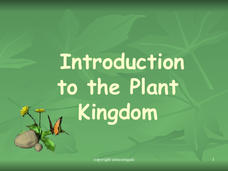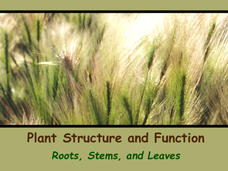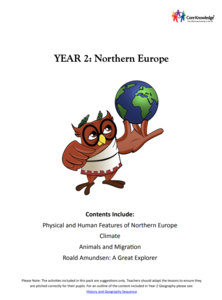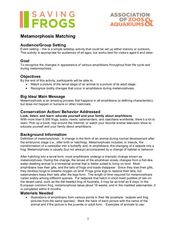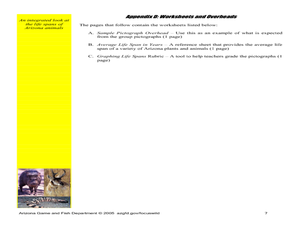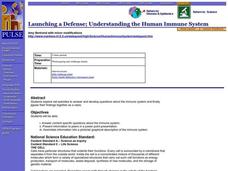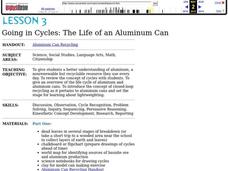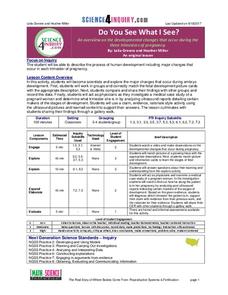BBC
Ourselves
Young biologists identify parts of the body, sort humans from other animals, and list the difference they see. Learners are split up into groups of three, and each group must find pictures in magazines of humans and other animals. They...
Curated OER
LP 6--8: Xenopus laevis (frog) Development for a 7th Grade Audience
Seventh graders view lab stations with Xenopus at different stages of development. They identify the life stage of the sample, as well as the previous and next stages. Students must explain their reason for selecting the specific stage.
Biology Junction
Introduction to the Plant Kingdom
Plants provide humans with food, shelter, and medications. Scholars gain a better appreciation for plants after learning their functions, divisions, and early ancestors. Each sub-topic includes slides highlighting vocabulary and...
Biology Junction
Plant Structure and Function: Roots, Stems, and Leaves
Scientists found fossils of plants more than 420 million years old—but plants existed for up to 100 million years prior to these fossils. Learn about the importance of plants to the entire planet. Viewing a presentation helps scholars...
Biology Junction
Cnidarians and Ctenophorans
Cnidaria is a broad phylum of 11,000 different species from jellyfish to coral. Most Cnidarians are marine species with a few freshwater examples. A lesson presentation explains the important characteristics of different species of...
Core Knowledge Foundation
Year 2: Northern Europe
How is life in Northern Europe different from other areas of the world? Historians journey through the various regions of Northern Europe discovering what type of climate, animals, and lifestyles exist in that section of the world. They...
Curated OER
Metamorphosis Matching
Students view pictures of animals as they complete the metamorphosis from a larva to an adult. In this metamorphosis lesson plan, students view pictures and in the end are able to match pictures of a larva stage to an adult stage in...
Curated OER
Charting Animal Life Spans
Second graders research animal life spans and complete related math activities. In this life span lesson, 2nd graders read How Many Candles and discuss life spans. Students arrange animal cards based on their life spans. Students find...
Curated OER
Dietary Supplements and the Chemistry of Life
Learners study the effects of dietary supplements on bodily functions. In this health lesson students calculate their caloric needs and research dietary supplements.
Curated OER
Launching a Defense; Understanding the Human Immune System
Students research online to answer and develop questions about immune system, create Powerpoint presentation to share information with classmates, and assimilate information into pictorial and/or graphical description of immune system.
Curated OER
I Wonder What Would Happen if Lots of Manduca Lived in a Small Place...
Students discuss the reasons why humans fight and look for similiarties in animals. They make predictions on what they think will happen when they observe insect crowding. They make conclusions about their predictions to end the activity.
Curated OER
BOTTOMS UP?
Students view a Magic School Bus video that teaches about the digestive system. They create a life-size model of the digestive system.
Curated OER
Rosa Parks
Students explore the life and works of Rosa Parks. In this Civil Rights lesson, students consider Rosa Parks' work as a philanthropist. Students then write a letter to someone that they admire for making a difference.
Curated OER
Word Art with King's Words
Students investigate equality and racism by creating a word art project. In this civil rights lesson, students discover the life of Martin Luther King Jr. and create a word art project using the Internet site Wordle Web. ...
Curated OER
Sustainability and Extinction
Galapagos Penguins are the only penguins on earth that live north of the equator (in the wild). In this last lesson plan a discussion on how the Galapagos islands developed their populations and diversity sparks the introduction. Two...
Bright Hub Education
The Winter of Our Discontent
The resource gives some basic concepts concerning the title of the novel, basic literary elements, student developed assessments, and a philosophical notion concerning honesty in literature. The instructors are shown where they can...
Curated OER
A Look at the Life That Electronics Lead
For this comprehension worksheet, students fill in ways on a graphic organizer that people or companies can conserve energy, reduce waste or minimize the impact to the environment. Next, students solve 3 "environmental" math word problems.
Curated OER
Going in Cycles: The Life of an Aluminum Can
Students investigate the manufacture of aluminum cans and consider the energy and resources saved when the cans are made from recycled material. They explore the concept of closed-loop recycling using charts, worksheets and discussion.
Curated OER
Pregnancy, Day 1: The Developing Baby
Twenty-six pages of good information about pregnancy. Pictures and descriptions describe the moment the sperm and egg unite, and there are worksheets that students can complete. This is a pretty comprehensive lesson for one day. It might...
Poetry Society
War Horse and WWI Poetry
Here's a resource that deserves a place in your curriculum library. As part of their study of War Horse individuals create an anthology of World War I poetry.
Science 4 Inquiry
Do You See What I See?
In only nine months, a small group of cells grows into a fully developed baby. Pupils learn about the development of an embryo to a fetus to a baby. They identify each step of weekly development. Young scientists look at ultrasounds to...
Curated OER
Zebrafish as a Model for Muscle Development
Students explore the steps of protein synthesis in zebrafish. They view video clips to identify the parts of a zebrafish and observe them as they sequence the developmental stages. In groups they identify the muscles and how proteins are...
Curated OER
Lives of Stars
Young scholars explain in their own words how stars are formed. In this space science lesson, students summarize the life cycle of stars. They draw diagrams and label the step of the cycle they represent.
Curated OER
Natural Selection
Students estimate how many different species of organisms inhabit the Earth. In groups, they match the pictures of embryos at the different stages of development. They compare and contrast animals from the sky, land, and water and...


